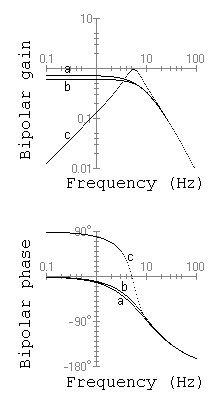
Retinal horizontal cells (HCs) provide an opponent signal coding for spatial and colour contrasts by regulating the synaptic transmission between receptors and bipolars (Bs) in triad synapses. According to Bysov's hypothesis on ephaptic feedback, the postsynaptic current from HCs would depolarize presynaptic release sites and increase transmitter release, thus 1) creating a positive intrasynaptic feedback for HCs and 2) regulating signal transmission from receptors to Bs. For synchronization of opponent signals this regulation must be sufficiently rapid. The models of the ephaptic feedback fairly well simulated the HC dynamics [1], including transients, but its frequency transfer properties remained unknown.
Frequency response functions (FRFs) of visual signal transmission to HCs and Bs in the model of triad synapse with an ephaptic feedback were calculated. An influence of different factors on the shape of amplitude and phase FRFs was investigated. Some factors (such as low rates of transmitter release and removal from synaptic cleft, noticeable capacity of cell membranes) inevitably restrict the rate of transmission. The other factors were demonstrated to expand the frequency range, that is essential for synchronization of opponent signals: 1) a transient component of transmitter release which accentuates high frequencies, 2) a voltage-dependent conductance of the HC non-synaptic membrane.
The model is designed as a 32-bit Windows (Windows 9x, Windows NT, Win32s) application.

 Three versions of the I-V curves for HC membrane used in calculations with
different slopes of linear parts: a - 'passive' membrane; b - membrane
with infinite slope resistance operating as a current stabilizer; c - 'active'
membrane with negative resistance. The other parameters of the model
correspond to rather 'slow' cells in the pike retina [1].
Three versions of the I-V curves for HC membrane used in calculations with
different slopes of linear parts: a - 'passive' membrane; b - membrane
with infinite slope resistance operating as a current stabilizer; c - 'active'
membrane with negative resistance. The other parameters of the model
correspond to rather 'slow' cells in the pike retina [1].
 Amplitude and phase FRFs for HCs. |
 Amplitude and phase FRFs for Bs. |
ACKNOWLEDGEMENTS
 This work was supported by a research grant (98-04-49298) from the Russian
Foundation for Basic Research.
This work was supported by a research grant (98-04-49298) from the Russian
Foundation for Basic Research.
Questions and comments to
Back to IITP Laboratory 8 Activity Page
Back to IITP Electronic Posters Page
Back to IITP Projects Page ( IITP russian Projects Page )
Last Update: 16 January, 2001